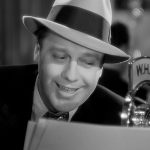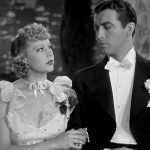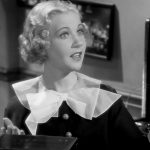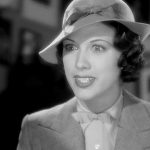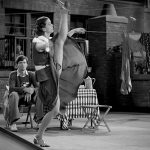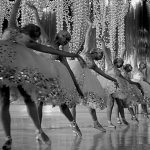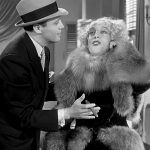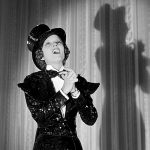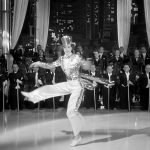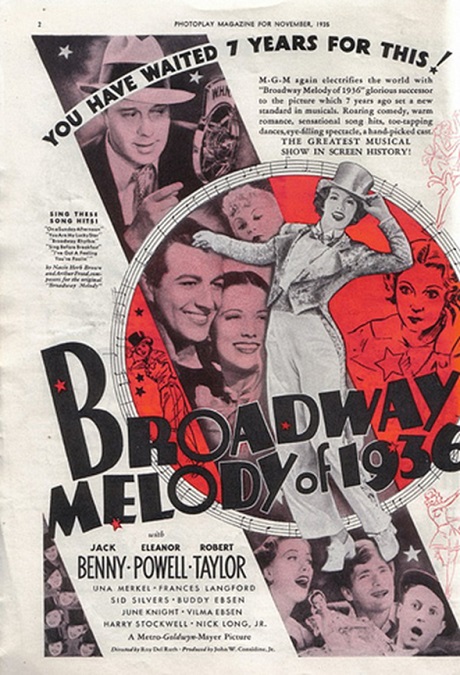
Broadway Melody of 1936 – 1935
I really wanted to roll my eyes at this film. I wanted to. But it had such a cute little story, I couldn’t. Directed by Roy Del Ruth, this little gem was fun and entertaining. It had a few cute songs and a lot of incredible tap-dancing. It starred Jack Benny, Eleanor Powell, Robert Taylor, Francis Langford, Sid Silvers, Una Merkel, June Knight, and Buddy and Vilma Ebsen. I was just expecting to see the same old dance moves set against the same old shallow plot. But I was wrong.
The plot had a little complexity, though I’ll admit, very little. The acting was nothing special, except maybe for Benny, Merkel, and Silvers. They stood out to me as better actors than the rest of the cast. Silvers was the film’s comic relief and even had a few scenes in which he was supposed to impersonate a woman, so he dressed in drag. Of course, once it was determined that he could never pass as a woman, he could have changed back into his own clothes. But for some reason, he stayed in the dress. Apparently a man dressed as a woman was comedy back then.
Each character was a bit of a stereotype, some more than others. For instance, Benny played the sleazy reporter who would do anything to get his little tabloid stories. For him, truth was never terribly important. Taylor played the jaded, womanizing producer, Knight played the spoiled heiress, and Powell played the unknown woman who just needed a chance, and who can dance circles around anyone. Merkel played the witty secretary with the heart of gold, and Silvers played Benny’s comedic sidekick with the motor-mouth. Bring them all together and you have a cute little story with very little depth, but a lot of fun and dancing.
Bert Keeler, played by Benny, is told to dig up Broadway dirt in order to sell newspapers or he will lose his job. So he and his assistant Snoop Blue, played by Silvers, target Broadway producer Robert Gordon, played by Taylor, and his rich and spoiled financer, Lilian Brent, played by Knight. They invent gossip about the two to print in their rag. Irene Foster, played by Powell, wants to be a big Broadway star. She was once the childhood sweetheart of Mr. Gordon, though he doesn’t recognize her at a glance. When he finally does, he tells her to abandon her dreams of stardom and go home to Albany.
In order to get new dirt on Gordon, Snoop gets cozy with Gordon’s secretary, Kitty Corbett, played by Merkel. Through her, he learns that the producer is looking for a lead for his new show. In order to cause chaos, Keeler invents an unknown French actress and builds her up in his paper to be the best thing since sliced bread. Kitty discovers the plot and devises a plan in which Irene poses as the fictitious actress. Inexplicably, Gordon doesn’t recognize her… again. But when Keeler finds out that Irene is posing as his made up girl, he knows she is a fraud. He threatens to expose her unless she leaves the show. But in the end Irene exposes herself by dancing for Gordon. Mr. Gordon and Irene proclaim their love and get married. Happy ending!
I am always impressed with tap dancing, which was the primary form of dance in the film. But one sequence stood out in my mind as unique. The dance number that took place when Mr. Gordon is making a bargain with Lilian Brent. He goes out of his way to woo her in order to get her financial backing, and though she doubts him at first, she quickly falls under his charming spell. The two sing I’ve Got a Feeling You’re Foolin. As they danced around a balcony at a restaurant, items kept popping up out of the floor like constructs in a pop-up book like a full sized piano, or a fully set romantic dinner table with chairs. And the backup dancers had quick costume changes that were facilitated by cleverly implemented split-screen effects.
And the music, while only slightly memorable, was well-sung. In fact, when any real singing had to be done, the star singer, Frances Langford, was brought out to croon her way into our hearts. But even that took a back seat to Powell’s dancing. She was amazing! Her high kicks were ridiculously high. And she did this move where she could bend over backward and touch the floor, then lift herself back to her feet, all in one swift, swanky motion. In the finale dance number, Langford started belting out the up-tempo tune, Broadway Rhythm. But when Powell took the floor, my jaw nearly dropped. There were times she was spinning faster than a figure skater. And she did it all with a big bright smile on her face.
And finally, I’d like to mention the cute performances of Buddy Ebsen and his sister Vilma. Buddy had a really easy and charming country-bumpkin sort of demeanor. His dance moves all seemed gentle and yet precise and deliberate. But the movie had one really stupid comedic subplot that might have been amusing if it had only been a single scene. But they kept it going throughout the entire film as a running gag. The ridiculous character of Hornblow, played by Robert John Wildhack, who tried to get onto Gordon’s show to show off his talent for the many and varied, and categorically organized, forms of snoring. He was like a person with asperger’s who never misses a chance to display his talent and bore everyone to death. That whole thing should have been cut. It just wasn’t funny.
